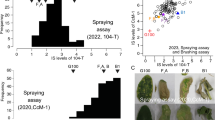Abstract
Before likely sources of resistance in pea to Mycosphaerella pinodes can be exploited in a breeding program, the inheritance of genetic mechanisms governing the variation in resistance need to be understood. Disease responses were first examined in a diallel cross of nine Pisum sativum genotypes. An analysis of variance of parental and F1 data detected significant additive and dominance variation but no reciprocal effects. Gene interactions were not significant in leaves with the exception of the line JI 252 and there was no association detected between the frequencies of dominant or recessive alleles and parental disease response. In stems, the slope of the regression line of the covariance if array members with their non recurrent parent on the variance of an array was significantly different from one and the additive-dominance model was therefore rejected. The non-significance of interactions among genes determining disease response in leaves was supported by the triple test cross analyses. These analyses showed that the narrow-sense heritability of disease response was higher in crosses involving SA 1160 than in the cross Wirrega × Austrian Winter. These crosses are likely to generate inbred lines more resistant to M. pinodes infection than either parent.
Similar content being viewed by others
References
Ali, S.M., 1983. Pathotypes of ‘black spot’ complex pathogens of field peas, selection and inheritance of resistance in pea lines, pp. 246–248. Standing Committee on Agriculture, Adelaide, Australia.
Ali, S.M., L.F. Nitschke, A.J. Dube, M.R. Krause & B. Cameron, 1978. Selection of pea lines for resistance to pathotypes of Ascochyta pinodes, A. pisi and Phoma medicaginis var. pinodella. Aust. J. Agric. Res. 29: 841–849.
Beale, P.E. & N. Thurling, 1980. Genetic control of resistance to Kabatiella caulivora in Trifolium subterraneum subspecies yanninicum. I Diallel analysis of variation in disease development parameters. Aust. J. Agric. Res. 31: 927–933.
Bretag, T.W., 1991. Epidemiology and Control of Ascochyta Blight of Field Peas. PhD Thesis, pp. 1–297. La Trobe University, Victoria, Australia.
Bretag, T.W., P.J. Keane & T.V. Price, 1995. Effects of ascochyta blight on the grain yield of field peas (Pisum sativum L.) grown in southern Australia. Aust. J. Expt. Agric. 35: 531–536.
Brouwer, J.B., 1993. Field pea cultivar development in Victoria. Report of the Field Pea Breeding Workshop, 1993. Victorian Institute for Dryland Agriculture, Horsham.
Clulow, S.A., 1989. The Resistance of Pisum to Mycosphaerella pinodes (Berk. & Blox.) Vestergr. PhD Thesis, pp. 1–198. The University of East Anglia, Norwich.
Clulow, S.A., P. Matthews & B.G. Lewis, 1991. Genetic analysis of resistance to Mycosphaerella pinodes in pea seedlings. Euphytica 38: 183–189.
Clulow, S.A., B.G. Lewis & P. Matthews, 1992. Expression of resistance to Mycosphaerella pinodes in Pisum sativum. Plant Pathol. 41: 362–369.
Comstock, R.E. & H.F. Robinson, 1952. Estimation of average dominance of genes. In: J.W. Gowen (Ed.), Heterosis, pp. 494–516. Iowa State College Press, Iowa.
Day, P.R., 1974. Genetics of Host-Parasite Interaction. Freeman and Co., San Francisco.
Gilbert, N. E., 1958. Diallel crossing in plant breeding. Heredity 12: 477–492.
Hayman, B.I., 1954. The theory and analysis of diallel crosses. Genetics 39: 789–809.
Heath, M.C. & R.K.S. Wood, 1969. Leaf spots induced by Ascochyta pisi and Mycosphaerella pinodes. Ann. Bot. 33: 657–670.
Hill, J., 1964. Effects of correlated gene distributions in the analysis of diallel crosses. Heredity 19: 27–46.
Jinks, J.L., 1954. The analysis of continuous variation in a diallel cross of Nicotiana rustica varieties. Genetics 39: 767–788.
Jinks, J.L. & J.M. Perkins, 1970. A general method for the detection of additive, dominance and epistatic components of variation III. F2 and backcross populations. Heredity 25: 419–429.
Jinks, J.L. & H.S. Pooni, 1976. Predicting the properties of recombinant inbred lines derived by single seed decent. Heredity 36: 253–266.
Kearsey, M.J. & J.L Jinks, 1968. A general method of detecting additive, dominance and epistatic variation for metrical traits. Heredity 23: 403–409.
Lawyer, A.S., 1984. Foliar diseases caused by fungi: diseases caused by Ascochyta spp. In: D.J. Hagedorn (Ed.), Compendium of Pea Diseases, pp. 11–15. American Phytopathological Society, St Paul.
Lynch, M. & B. Walsh, 1998. Genetics and Analysis of Quantative Traits. Sinauer Associates Inc., Massachusetts.
Maunder, A.B., 1992. Identification of useful germplasm for practical plant breeding programs. In: H.T. Stalker & J.P. Murphy (Eds), Plant Breeding in the 1990s, Proceedings of the Symposium on Plant Breeding in the 1990s, pp. 147–169. Redwood Press Ltd, Melksham.
Nasir, M., H.-H. Hoppe & F. Ebrahim-Nesbat, 1992. The development of different pathotype groups of Mycosphaerella pinodes in susceptible and partially resistant pea leaves. Plant Pathol. 41: 187–194.
Parlevliet, J.E., 1992. Selecting components of partial resistance. In: H.T. Stalker & J.P. Murphy (Eds), Plant Breeding in the 1990s, Proceedings of the Symposium on Plant Breeding in the 1990s, pp. 218–302. Redwood Press Ltd, Melksham.
Wearden, S., 1964. Alternative analysis of the diallel cross. Heredity 19: 669–680.
Wroth, J.M., 1996. Host-pathogen relationships of the ascochyta blight (Mycosphaerella pinodes (Berk. & Blox.) Vestergr.) disease of pea (Pisum sativum L.). PhD Thesis, pp. 1–229. The University of Western Australia, Australia.
Wroth, J.M., 1998. Variation in pathogenicity among and within Mycosphaerella pinodes populations collected from field pea in Australia. Can. J. of Bot. 76: 1955–1966.
Wroth, J.M. & T.N. Khan, 1998. Differential responses of field pea (Pisum sativum L.) to ascochyta (Mycosphaerella pinodes) — rating disease in the field. Aust. J. Agric. Res. 50: 605–615.
Zlamal, P., 1984. Genetics of horizontal resistance to anthracnose in peas. Sbornik UVTIZ, Genetika a Slechteni 20: 181–192. (Abstract: Rev. Plant Pathol. (1986) 65: 344.)
Author information
Authors and Affiliations
Rights and permissions
About this article
Cite this article
Wroth, J.M. Evidence suggests that Mycosphaerella pinodes infection of Pisum sativum is inherited as a quantitative trait. Euphytica 107, 193–204 (1999). https://doi.org/10.1023/A:1003688430893
Issue Date:
DOI: https://doi.org/10.1023/A:1003688430893




